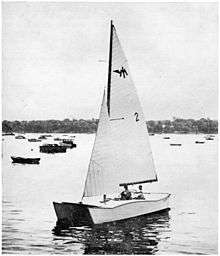Naramatac
|
Naramatac on the water. | |
| Development | |
|---|---|
| Designer | Robert B. Harris |
| Location | United States |
| Year |
1948 (design)[2] 1950 (launch)[3] |
| Role | day sailer[1] |
| Hull | |
| Type | catamaran |
| LOA | 25 ft (7.6 m)[1][4] |
Naramatac was a catamaran sailboat designed by Robert B. Harris in 1948[1][2] and launched in 1950,[3] mostly notable for[5] its innovative use of asymmetric hulls,[1] later to become the hallmark of the Hobies.
Concept
| “ | I was looking for a day sailer which, though not necessarily a speed demon, would easily go by other boats of her size, would manoeuvre well and go to windward. I also paid some attention to making her easy to build with thoughts for the home builder. | ” | |
| — Robert B. Harris[1] | |||
Efficacy
Harris' design was not entirely successful, however. At speed the flat bottoms pounded, and it showed poor performance in low wind which he ascribed to deep hulls (particularly aft), lack of stability to carry additional sail, too much wetted surface, and too heavy construction.[1]
| “ | While the trials of Naramatac demonstrated her speed to be proportional to Manu Kai and proved that a small catamaran was practical, they also showed that she was sluggish in maneuver, slow in light to moderate winds, had far too much longitudinal motion, and lacked stability due to excessive narrowness in hull spacing. | ” | |
| — Robert B. Harris[3] | |||
See also
References
- 1 2 3 4 5 6 7 Robert B. Harris. "Three Double Hulled Craft" (PDF).
- 1 2 "Robert B. Harris".
- 1 2 3 "Amateur Yacht Research Society Publication #10: American Catamarans" (PDF).
- ↑ "Index of images in AYRS archives". AYRS.
- ↑ Dieter Loibner (November 2011). "The cat-crazy men who got me sailing".
This article is issued from Wikipedia - version of the 10/19/2016. The text is available under the Creative Commons Attribution/Share Alike but additional terms may apply for the media files.
